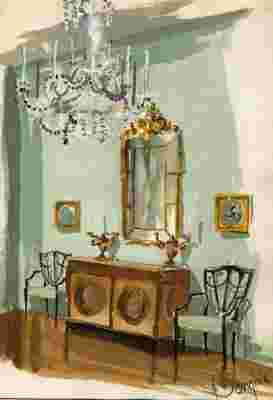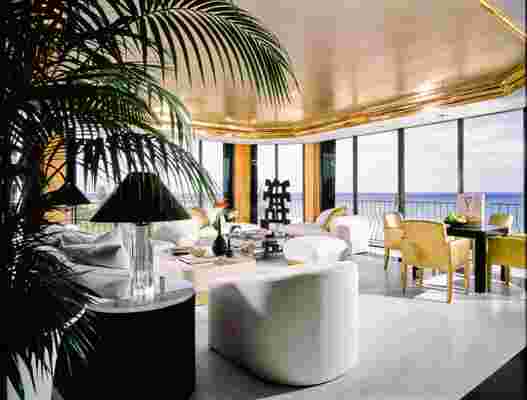Ralph Lauren admits he was a trifle surprised when he and his wife, Ricky, moved into their freshly remodeled Fifth Avenue duplex in 1979. Angelo Donghia, America’s hottest designer, had scraped the prewar envelope to the bone, leaving behind only naked herringbone parquet and floor-hugging white sofas, with not a single work of art or molding to relieve the unadorned walls.
“We were taken aback because I was trying to break new ground, and Angelo didn’t really do that kind of thing,” the fashion powerhouse says. “But he took a sophisticated New York apartment and turned it into an uptown loft. After long days filled with color and patterns, it was like coming home to a beautiful white oasis.”
The dapper Donghia (1935–1985) was more than just a decorator: He was a style colossus, thanks to both his protean talent and his pioneering creative diversification, which lives on in the company bearing his name. This fall, “Angelo Donghia: Design Superstar,” a retrospective at the New York School of Interior Design, investigates not only how the entrepreneurial aesthete shaped rakishly sensual rooms for Halston, Diana Ross, and Liza Minnelli but also how he and his team created line after line of products, from overstuffed sofas offered through to-the-trade showrooms to shirts and ties sold at Bloomingdale’s.
“I’m a gambler,” Donghia told journalist Barbaralee Diamonstein-Spielvogel in 1981. “What’s the worst that could happen? I’d fall on my tail, and I’d get up again.” His first major mass-market furniture collection, unveiled in 1977, indeed flopped—not enough personal oversight, he claimed—but his 1974 Window Pane bedding for J. P. Stevens brought in more than $8 million.
As those popular plaid sheets hinted, along with the gray flannel upholstery that became one of his signatures, Donghia was a tailor’s son, raised among the steel mills of western Pennsylvania. Trips to Pittsburgh introduced him to a sophisticated world through the inventive window displays and room settings at Kaufmann’s, a department store whose owner, Edgar J. Kaufmann Sr., commissioned the Frank Lloyd Wright masterpiece Fallingwater.
Smitten, the teenage Donghia headed to New York’s Parsons School of Design, graduating in 1958 and landing a sales job with Yale R. Burge, a carriage-trade purveyor of Continental antiques. The ambitious young man cannily made himself indispensable and soon became Burge’s business partner. After Burge’s death in 1972, Donghia the empire was born.
“Most people, especially the younger generation, aren’t aware there was a man behind the firm,” says Chuck Chewning, Donghia’s current creative director. “Or that he saw design as a business, believing decorators didn’t know how to capitalize on money-making opportunities.”



As Donghia once opined, “I do nothing for nothing.” Socializing with clients was discouraged because it muddied the professional waters—“You would not go out and have cocktails with your doctor,” he said—and bread-and-butter decorating projects were eschewed in favor of ka-ching commissions such as PepsiCo’s worldwide headquarters. “I would like to help everyone,” the designer noted, “but I have a lot of people working for me, and I have my own survival to think about.”
Donghia didn’t just survive; he flourished. His 1966 decor for Lincoln Center’s Metropolitan Opera Club—silver ceiling, glossy brown walls, stools touched with Lucite—wowed its tuxedoed members and made national news. A couple of years later he opened & Vice Versa, a showroom of effervescent fabrics that played a part in his early pattern-on-pattern interiors. Plus-size seating with arms up to ten inches wide followed, starting a craze. (One newspaper headline crowed, “He Stays Slim, but His Furniture Gets Fatter.”) Donghia even helped make Key West hip, becoming one of the Florida island’s most prominent seasonal residents.
By the time Donghia died, an early casualty of the AIDS epidemic, his aesthetic had grown so spare that he called it “throwaway design.” Yet, as tastemaker Albert Hadley told the Laurens upon visiting their less-is-more duplex, “My advice to you is to touch nothing—it’s perfect as it is.” And, with only a few sympathetic alterations, so they have. “It was such a gift,” Ralph Lauren says. “After all these years, it’s still our home, filled with the spirit that Angelo helped create.” Exhibition runs from Sept. 17 to Dec. 5; nysiddu
